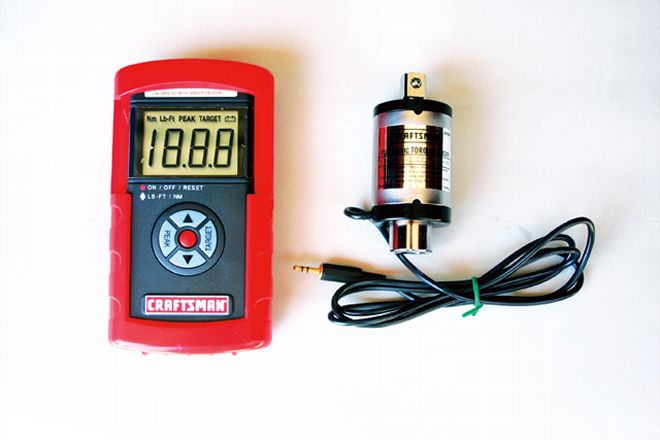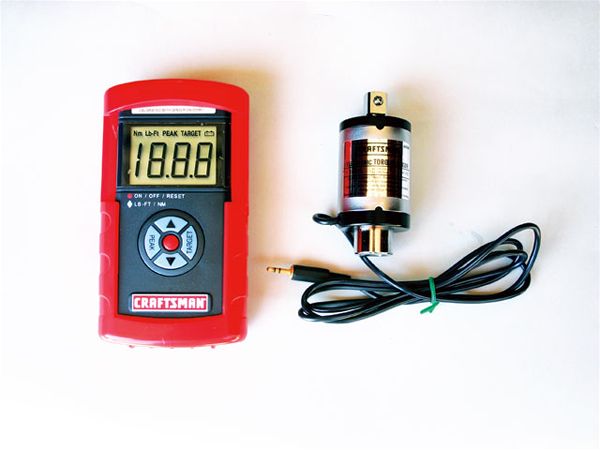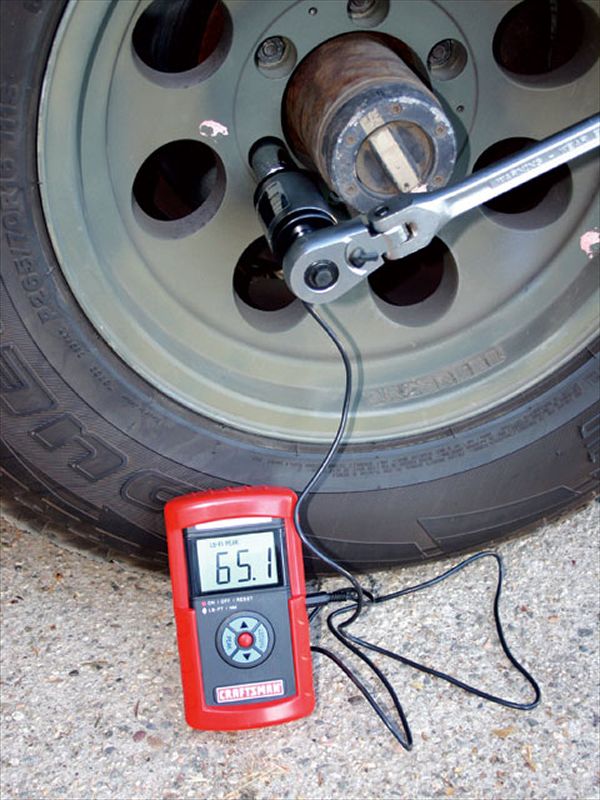
 Much easier to use than a beam-type but not as fast as a clicker torque wrench, Craftsman's Electronic Rotary Torque Sensor System is very useful in many situations. Those five buttons in the center are for changing between the modes, set the target value, switch between pound-feet and Newton meter, and to turn the unit on and off. Its 9-volt battery seems to last a long time, and it shuts itself off after about seven minutes of inactivity. The sensor's outer body rotates very freely so there's no need to worry about snagging the cable.
Much easier to use than a beam-type but not as fast as a clicker torque wrench, Craftsman's Electronic Rotary Torque Sensor System is very useful in many situations. Those five buttons in the center are for changing between the modes, set the target value, switch between pound-feet and Newton meter, and to turn the unit on and off. Its 9-volt battery seems to last a long time, and it shuts itself off after about seven minutes of inactivity. The sensor's outer body rotates very freely so there's no need to worry about snagging the cable.
If your idea of torquing a fastener is to tighten it until it starts turning more freely again and then back off half a turn, just turn the page and keep looking at the pretty pictures. For those of us who care about our machinery, a torque wrench is a must-have item, and not only for building engines. Most people tend to overtighten things which stretches the fastener too much, effectively ruining it. Some don't lean hard enough on the wrenches, creating a much weaker clamping force than intended. Even mundane tasks like installing a tow hitch or changing wheels requires getting the torque right, and using a torque wrench is about the only way to get the correct clamping force. The most common torque wrench is a so-called "clicker" that makes an audible sound when reaching the set torque value, which can also be felt in the wrench. Those look and work much like a regular ratchet, have a 1/2- or 3/8-inch drive for sockets, and are useable pretty much wherever a ratchet would work. They'll set you back from $100 to $200 for a good one.
Penny pinchers and masochists can get by with a beam-style torque wrench for around $25 to $70. This dirt-simple type bends with the force and a pointer shows the torque value on a scale, which is just fine if you can work in a position where you can read the scale while tightening the fastener. Yup, there's a reason they're cheap, and not very popular.
 Some free-wheeling hubs don't leave much room for getting to the lug nuts, but the Rotary Torque Sensor does fit on a GM. Better yet, the sensor's 4-inch length combined with a deep socket eliminated the need for an extension, making the torque reading for the lug nuts accurate for a change. Normally we use an extension, which you're not supposed to do with any torque reading instrument as it alters the value. It's obviously OK to use extensions between the sensor and ratchet, which is a big advantage of the Torque Meter. Also, the length of the ratchet or breaker bar can be varied to your liking, but you'll always need both hands on the ratchet with this setup. It would be great if the Torque Meter could be used with an impact wrench, but predictably, the instructions specifically say not to. Oh, and that you need to wear eye protection. No surprise there, either.
Some free-wheeling hubs don't leave much room for getting to the lug nuts, but the Rotary Torque Sensor does fit on a GM. Better yet, the sensor's 4-inch length combined with a deep socket eliminated the need for an extension, making the torque reading for the lug nuts accurate for a change. Normally we use an extension, which you're not supposed to do with any torque reading instrument as it alters the value. It's obviously OK to use extensions between the sensor and ratchet, which is a big advantage of the Torque Meter. Also, the length of the ratchet or breaker bar can be varied to your liking, but you'll always need both hands on the ratchet with this setup. It would be great if the Torque Meter could be used with an impact wrench, but predictably, the instructions specifically say not to. Oh, and that you need to wear eye protection. No surprise there, either.
Craftsman recently came out with an alternative to either type, the Torque Meter, which isn't a wrench but an accessory. This "torque wrench" consists of a Rotary Torque Sensor and a Meter, collectively called an Electronic Rotary Torque Sensor System. Its sensor goes between a ratchet and a socket, acting as a 4-inch extension, sending data to the meter through a 4-foot cord. Electronics in the meter give a digital readout of real-time torque applied to the sensor, can store peak values, and can, naturally, be set to a desired max torque number, the so-called Target Mode. For about $120 (PN 44599), this instrument seems like a darn practical tool, but is it? Yes and no.
We wouldn't want one as our primary torque wrench, and largely for the same reasons we don't like the beam-type. Sure, you could use this one behind your back and still look at the meter, or rely on the audio signals in Target Mode, but you can't feel when the correct torque is reached as with a clicker wrench. And the arcadelike sound effects of the Target Mode took some getting used to. The meter will start beeping at 50 percent of desired value, then the beeps get faster as the dialed-in value approaches, after which the tone gets continuous when within 5 percent. Exceeding the set value by 5 percent sets off an alarm, which stays on for a few seconds. All in all, it's reminiscent of a frenzied pinball machine, until you learn to sort the various noises out.
Fitting the 1 3/4-inch-diameter sensor in the work space can also be an issue, but then again, the whole setup fits much easier in a small toolbox than does a regular torque wrench and it's a lot lighter. We've come across several situations where the sensor wouldn't fit, but there are many where a regular clicker couldn't be used, either. Capable of 15- to 150-lb-ft measurements (though more accurately above 50, at +/- 3%) the Torque Meter's range is useable for most projects in the garage or on the trail. Check this thing out-you just might want one to complement the clicker.